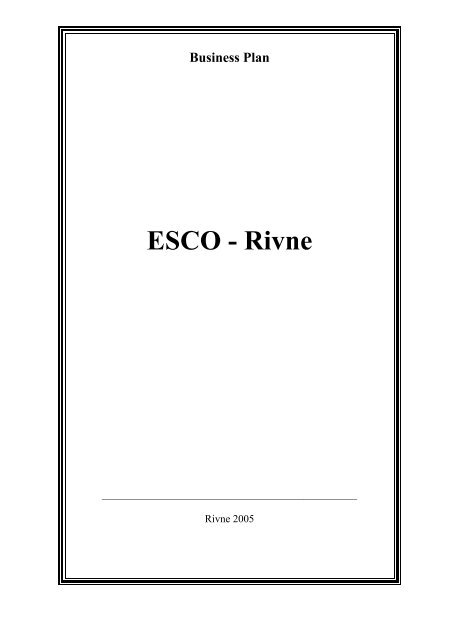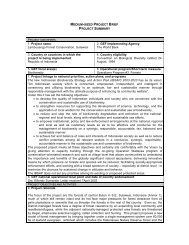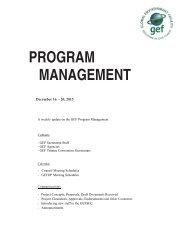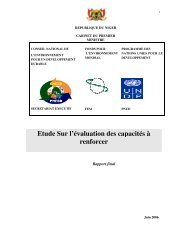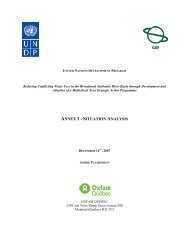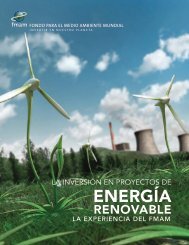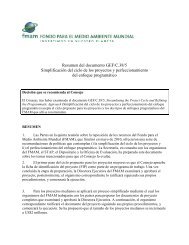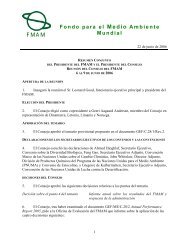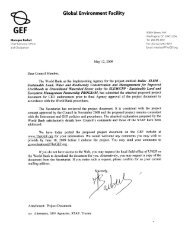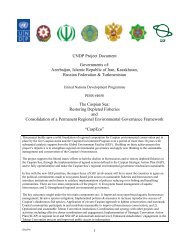Business Plan ESCO - Rivne - Global Environment Facility
Business Plan ESCO - Rivne - Global Environment Facility
Business Plan ESCO - Rivne - Global Environment Facility
You also want an ePaper? Increase the reach of your titles
YUMPU automatically turns print PDFs into web optimized ePapers that Google loves.
<strong>Business</strong> <strong>Plan</strong><br />
<strong>ESCO</strong> - <strong>Rivne</strong><br />
________________________________________________<br />
<strong>Rivne</strong> 2005
Municipal Energy Service Company of <strong>Rivne</strong> <strong>ESCO</strong>-<strong>Rivne</strong><br />
Table of Contents<br />
Abbreviations and Acronyms.............................................................................................................................. 3<br />
Appendixes................................................................................................................................3<br />
APPENDIX 1: Drafts of the Energy Performance Contracts ................................................ 3<br />
APPENDIX 2: Financial <strong>Plan</strong> for the years 2005-2008......................................................... 3<br />
APPENDIX 3: Scheme of Work with Budget Institutions...................................................... 3<br />
APPENDIX 4: Company Management 3D Structure1. EXECUTIVE SUMMARY........ 3<br />
1. EXECUTIVE SUMMARY............................................................................................ 4<br />
1.1 Background ............................................................................................................................................. 4<br />
1.2 Objectives................................................................................................................................................ 5<br />
1.3 Mission.................................................................................................................................................... 5<br />
1.4 Keys to Success....................................................................................................................................... 5<br />
2. COMPANY SUMMARY............................................................................................... 6<br />
2.1 Justification ............................................................................................................................................. 6<br />
2.2 Ownership ............................................................................................................................................... 6<br />
2.3 Company Location and facilities............................................................................................................. 7<br />
2.4 <strong>Business</strong> Concept .................................................................................................................................... 7<br />
2.4.1 Energy performance contracts (EPC) .................................................................................................. 7<br />
2.4.2 The process............................................................................................................................................ 8<br />
2.4.3 Defining the Scope ................................................................................................................................9<br />
2.4.4 Benefits .................................................................................................................................................. 9<br />
2.5 Start-up <strong>Plan</strong>.......................................................................................................................................... 10<br />
3. PRODUCTS AND SERVICES ................................................................................... 10<br />
3.1 Service Description ............................................................................................................................... 10<br />
3.2 Competitive Comparison ...................................................................................................................... 10<br />
3.3 Fulfilment.............................................................................................................................................. 10<br />
3.4 Expected Results and Comparative Advantage..................................................................................... 10<br />
3.5 Sourcing ................................................................................................................................................ 11<br />
3.6 Financial <strong>Plan</strong>........................................................................................................................................ 11<br />
4. MARKET AND CLIENTS.......................................................................................... 11<br />
4.1 Situational Analysis .............................................................................................................................. 11<br />
4.2 Market Summary................................................................................................................................... 12<br />
4.2.1 Energy saving market indications: ..................................................................................................... 12<br />
4.2.2 Energy saving potential: ..................................................................................................................... 13<br />
4.2.3 Actual volume of the local energy-saving market .............................................................................. 14<br />
4.2.4 Demand structure at local energy saving market............................................................................... 14<br />
4.2.5 Market Demographics......................................................................................................................... 14<br />
4.2.6 Market Segments................................................................................................................................. 15<br />
4.2.7 Target Markets and Clients................................................................................................................. 17<br />
4.2.8 <strong>ESCO</strong>-<strong>Rivne</strong> Clients’ Characteristics................................................................................................. 18<br />
4.2.9 Market / Clients’ Needs....................................................................................................................... 18<br />
4.2.10 Market Trends ................................................................................................................................... 18<br />
4.2.11 Market Growth .................................................................................................................................. 19<br />
4.3 SWOT Analysis .................................................................................................................................... 20<br />
4.4 Competition........................................................................................................................................... 22<br />
4.5 Services ................................................................................................................................................. 22<br />
4.6 Keys to Success..................................................................................................................................... 23<br />
4.7 Critical Issues........................................................................................................................................ 23<br />
5. MARKETING STRATEGY ....................................................................................... 23<br />
5.1 Mission.................................................................................................................................................. 24<br />
5.2 Marketing Objectives............................................................................................................................ 24<br />
5.3 Financial Objectives.............................................................................................................................. 24<br />
5.4 Target Markets ...................................................................................................................................... 24<br />
5.5 Positioning ............................................................................................................................................ 24<br />
5.6. Strategy Pyramids ................................................................................................................................. 25<br />
5.7 Marketing Mix ...................................................................................................................................... 25<br />
5.8 Marketing Research .............................................................................................................................. 26<br />
<strong>Business</strong> <strong>Plan</strong> - 2005 Page.2 from 31
Municipal Energy Service Company of <strong>Rivne</strong> <strong>ESCO</strong>-<strong>Rivne</strong><br />
6. STRATEGY AND IMPLEMENTATION................................................................. 26<br />
6.1 Marketing and Sales Strategies ............................................................................................................. 26<br />
6.2 Community Mobilization ...................................................................................................................... 27<br />
6.3 Public Relations Strategy ...................................................................................................................... 28<br />
6.4 Alliances................................................................................................................................................ 29<br />
6.5 Milestones ............................................................................................................................................. 29<br />
6.5 City-wide Energy-saving Program Details: .......................................................................................... 29<br />
7. ORGANISATION ........................................................................................................ 30<br />
7.1 <strong>ESCO</strong>-<strong>Rivne</strong> Activity............................................................................................................................ 30<br />
7.2 <strong>ESCO</strong>-<strong>Rivne</strong> Key Staff ......................................................................................................................... 30<br />
7.3 Management.......................................................................................................................................... 30<br />
Abbreviations and Acronyms<br />
AOA – Apartment-Owners Association<br />
CIS – Commonwealth of Independent states<br />
CO2 – Carbonic Acid Gas<br />
CO – Community Organization<br />
EPC – Energy-Performance Contract<br />
<strong>ESCO</strong> – Energy Service Company<br />
FG – Functional Group<br />
GEF – <strong>Global</strong> Ecology <strong>Facility</strong><br />
GDP – Gross Domestic Product<br />
GHG – Green House Gas<br />
NGO – Non-Governmental Organization<br />
PR – Public Relations<br />
UNDP – United Nations Development Programme<br />
Appendixes<br />
APPENDIX 1: Drafts of the Energy Performance Contracts<br />
APPENDIX 2: Financial <strong>Plan</strong> for the years 2005-2008<br />
APPENDIX 3: Scheme of Work with Budget Institutions<br />
APPENDIX 4: Company Management 3D Structure<br />
<strong>Business</strong> <strong>Plan</strong> - 2005 Page.3 from 31
Municipal Energy Service Company of <strong>Rivne</strong> <strong>ESCO</strong>-<strong>Rivne</strong><br />
1. EXECUTIVE SUMMARY<br />
1.1 Background<br />
Ukraine is one of the least energy efficient countries in the world and has the greatest<br />
emissions level per unit of GDP among CIS countries. A recent inventory of the total<br />
emissions from Ukraine showed the figures that significantly exceeds the levels in most<br />
European countries and is also one of the highest in the world. An inventory estimated that total<br />
emissions from Ukraine in 2002 were 487 million tons of CO2 equivalent (the corresponding figure for 2001 was<br />
482 million tons). This results in a per capita emission of 10 tons of CO2 equivalent per year. Heat supply in the<br />
buildings sector accounts for approximately 25% of all fuel consumed in Ukraine, and, therefore, there is a huge<br />
potential for energy efficiency improvement in this sector, which Ukraine wants to actively pursue.<br />
Problems in Ukrainian district heating are similar to those facing other countries of the former<br />
Soviet Union. Sharp increase in fuel prices up to the world level with heat tariffs lagging<br />
behind considerably worsened the financial state of all district-heating companies. Lack of the<br />
funds for modernization of generating capacities and heat networks impacted the level of<br />
service, which in combination with consumers' lower ability to pay significantly reduced the<br />
level of payment collection. Heat supply infrastructure is operated beyond the service life and<br />
requires large investments for maintaining it in operating condition and covering existing heat<br />
demand.<br />
At the same time, it is this inefficiency of existing heat supply and consumption systems that<br />
creates significant potential for fuel and energy saving. Heat supply in the buildings sector<br />
accounts for approximately 15% of all fuel consumed in Ukraine, and there is a huge potential<br />
for energy efficiency improvement in this sector illustrated by the following figures: Specific<br />
fuel consumption for heat generation in communal energy sector of Ukraine is 0.180-0.200<br />
t.c.e. per 1 Gcal compared to 0.150-0.160 t.c.e. in Western countries. Specific heat<br />
consumption for heating and hot water supply of Ukrainian buildings is 1.5-2 times higher<br />
than in Western countries with similar climate conditions.<br />
There exist a number of barriers that hinder supply and demand side energy efficiency<br />
improvement in district heating systems. These include: macro-economic conditions such as<br />
high taxes and unstable taxation policy, unstable local currency, inconsistency of regulatory<br />
and legal policies, non-payment crisis, imperfect pricing policy, institutional weaknesses,<br />
ownership questions, lack of information about existing opportunities for energy efficiency<br />
and relevant experiences, high transaction costs for relatively small energy efficiency projects,<br />
unsatisfactory financial state of district heating companies and consumers, difficulties in<br />
arranging financing for energy efficiency projects, lack of capacity and experience in<br />
preparing, implementing and managing energy efficiency projects, technical deficiencies of<br />
heat supplier and consumer systems, and the absence of incentives to energy saving for the<br />
majority of heat consumers.<br />
Energy service company (<strong>ESCO</strong>) can design, implement and finance all necessary energy<br />
efficiency investments in municipal buildings, the district heating networks and other energy<br />
consuming local facilities through energy performance contracts (EPC) or other suitable<br />
contractual arrangements. This approach aims at providing up-front investment through a<br />
portion of the savings actually realised. The <strong>ESCO</strong> concept represents an excellent vehicle for<br />
systematic energy efficiency as it deals with numerous clients, it is flexible in the decisionmaking<br />
process and - based on its business orientation – it is interested in multiplying energy<br />
efficiency activities through expansion of its customer base.<br />
<strong>Business</strong> <strong>Plan</strong> - 2005 Page.4 from 31
Municipal Energy Service Company of <strong>Rivne</strong> <strong>ESCO</strong>-<strong>Rivne</strong><br />
Community involvement through social mobilisation to the energy efficiency activities is very<br />
promising. Accordingly, all beneficiary households and other stakeholders in selected<br />
residential areas should participate fully in implementing energy saving initiatives. Through<br />
social mobilisation, communities should be sensitised and become aware of the benefits of<br />
energy efficiency measures through the <strong>ESCO</strong> approach - in terms of energy and cost savings,<br />
as well as in terms of the environmental impact (reduction of GHG emissions).<br />
1.2 Objectives<br />
<strong>ESCO</strong>-<strong>Rivne</strong> has doubled aim:<br />
(1) Support the energy efficiency development in communal sector of <strong>Rivne</strong> with further<br />
replication on other regions of Ukraine<br />
(2) Promotion of energy saving among the <strong>Rivne</strong> inhabitants.<br />
The first aim - support should be done through cooperation with local communal enterprises<br />
and local authorities, budget institutions etc. <strong>ESCO</strong>-<strong>Rivne</strong> has already established the<br />
necessary contacts and now in the phase of working out the projects.<br />
The second - universal experience shows that well-coordinated efforts are needed for<br />
convincing local communities in energy efficiency necessity.<br />
The major goal of <strong>ESCO</strong>-<strong>Rivne</strong> is to contribute through its initiatives to the reduction of<br />
greenhouse gas emissions through large-scale improvements in energy efficiency in the<br />
communal heat supply sector in <strong>Rivne</strong>.<br />
These improvements will result from a four-part approach:<br />
(1) Capacity building to create the basis for systematic energy efficiency activities at the<br />
local level;<br />
(2) An integrated approach of supply and demand-side improvements to achieve maximum<br />
fuel savings and emissions reduction;<br />
(3) Attraction of external investment resources for an energy efficiency program in <strong>Rivne</strong>;<br />
and,<br />
(4) Public awareness-raising through the involvement of communities and NGO's, in<br />
particular those concerned with environmental and energy efficiency problems.<br />
<strong>ESCO</strong>-<strong>Rivne</strong> does not limit its business activities by the municipal frames only. Company is<br />
prepared to develop and implement energy saving projects in other areas (the industrial sector<br />
and in non-manufacturing business).<br />
1.3 Mission<br />
Our mission is to provide clients across <strong>Rivne</strong> region and Ukraine with comprehensive energy<br />
saving services for all types of buildings, regardless of their ownership, - from concept<br />
planning and design works to turn key completion. All the works are done by highly skilled<br />
professional team working together, using common sense and practical experience.<br />
1.4 Keys to Success<br />
(a) Provide professional quality services on time and budget;<br />
(b) Guarantee the calculated energy savings;<br />
<strong>Business</strong> <strong>Plan</strong> - 2005 Page.5 from 31
Municipal Energy Service Company of <strong>Rivne</strong> <strong>ESCO</strong>-<strong>Rivne</strong><br />
(c) Develop a follow-up strategy to gauge performance with all clients;<br />
(d) Implement and maintain a quality control and assurance policy<br />
2. COMPANY SUMMARY<br />
2.1 Justification<br />
The <strong>ESCO</strong> business approach presents the most effective way for systematic energy<br />
efficiency activities for both supply and demand-sides and works at municipal level because it<br />
is oriented towards operation with numerous clients of various types, it reduces transaction<br />
costs and can tackle a large number of similar and relatively small-scale projects that could<br />
not be financed separately using traditional approaches. <strong>ESCO</strong> <strong>Rivne</strong> possesses the necessary<br />
expertise for project preparation and implementation; performs design works, building and<br />
assembly jobs balancing and commissioning; it is quick and flexible in making decisions<br />
about financing of projects and is intrinsically interested in multiplying energy efficiency<br />
activities through expansion of its customer base.<br />
2.2 Ownership<br />
The Municipal Energy Service Company was legally registered in the City of <strong>Rivne</strong> on<br />
November 12, 2003 as closed joint-stock company with the official name “<strong>ESCO</strong>-<strong>Rivne</strong>”.<br />
The shareholders are the Oblast Administration and City government (municipality). Due to<br />
the fact that Oblast Administration and City Government (municipality) are not legal entities<br />
<strong>ESCO</strong>-<strong>Rivne</strong>’s founders and stockowners are:<br />
• The District Heating Compamy “KomunEnergia“ (controlled by and reporting to Oblast<br />
Administration), 49.53% of stock shares and<br />
• The Municipal Enterprise “Misksvitlo” (controlled by and reporting to <strong>Rivne</strong><br />
municipality), 50.47% of stock shares.<br />
The Statutory fund (authorized initial capital) is approximately US$ 50’000.00 (see table<br />
below):<br />
<strong>ESCO</strong>-<strong>Rivne</strong><br />
No of Capital, UAH Shares<br />
Founders/shareholders Stocks<br />
DHC “KomunEnergia“ 53 132500,00 49.53%<br />
CE “Misksvitlo” 54 135000,00 50.47%,<br />
Total 107 267500,00 100.00%<br />
With the purpose of increasing the <strong>ESCO</strong>-<strong>Rivne</strong> employees’ personal commitment in<br />
Company’s potency and success the shareholders decided to hand over 10% of the shares to<br />
the <strong>ESCO</strong>-<strong>Rivne</strong> staff. Thus the shares ratio will change:<br />
<strong>ESCO</strong>-<strong>Rivne</strong><br />
No of Capital, UAH Shares<br />
Shareholders<br />
Stocks<br />
DHC “KomunEnergia“ 48 120000.00 44.53%<br />
CE “Misksvitlo” 49 122500.00 45.47%<br />
<strong>ESCO</strong>-<strong>Rivne</strong> staff 10 25000.00 10%<br />
Total 107 267500,00 100.00%<br />
<strong>Business</strong> <strong>Plan</strong> - 2005 Page.6 from 31
Municipal Energy Service Company of <strong>Rivne</strong> <strong>ESCO</strong>-<strong>Rivne</strong><br />
2.3 Company Location and facilities<br />
The <strong>ESCO</strong>-<strong>Rivne</strong> home office was established in the city of <strong>Rivne</strong>, North-West Ukraine. The<br />
office space is estimated to be 150 square meters. The office rooms are equipped with two<br />
telephone lines and high-speed Internet connection. Under the current UNDP cooperation the<br />
office has been fully renovated and equipped with computers and office equipment, telephone<br />
switchboard, etc. and will be transferred to <strong>ESCO</strong>-<strong>Rivne</strong> for once the project comes to an end.<br />
Similarly all other investments made by UNDP such as energy auditing equipment as well as<br />
the vehicle, etc. will be handed over to <strong>ESCO</strong>-<strong>Rivne</strong>. Company’s web-site is being<br />
developing and it is already used as a marketing tool. The domain name of “esco-rivne.com”<br />
has already been reserved. <strong>ESCO</strong>-<strong>Rivne</strong> Internet address is http://www.esco-rivne.com<br />
2.4 <strong>Business</strong> Concept<br />
The role of the <strong>ESCO</strong> <strong>Rivne</strong> is to design, realise and finance all necessary and cost effective<br />
investments in the municipal buildings, the district heating network or other energy<br />
consuming local facilities through energy performance contracts (EPC) or other applicable<br />
contracts, aimed at providing up-front investments, reducing the facilities' energy, operation<br />
and maintenance costs, and reimbursing the investments through a portion of the savings<br />
actually realized.<br />
2.4.1 Energy performance contracts (EPC)<br />
Energy performance contracting is a relative newcomer to the energy management industry in<br />
Ukraine, but it has been well established worldwide (particularly in the US and Canada) for<br />
over 10 years. An energy performance contract (EPC) is, in effect, an outsourcing<br />
arrangement for energy efficiency, where an external contractor takes total responsibility for<br />
achieving outcomes. This is the only form of energy management consultancy where it is<br />
possible to obtain a guarantee that energy savings will be achieved. You can performance<br />
contract a single savings measure, a whole building, or a whole organization. Bigger contracts<br />
are more cost effective.<br />
There are a number of different types of energy performance contract, but all share the<br />
following common features:<br />
• The EPC contractor enters into a long term (5-10 year) relationship with you.<br />
• Benchmark energy performance levels are defined and energy efficiency upgrades are<br />
identified and implemented by the EPC contractor.<br />
• Risk of non-performance of energy efficiency upgrades is carried by the EPC<br />
contractor rather than you.<br />
Thus EPCs are a means of achieving energy efficiency that allows the risks and<br />
responsibilities of implementation and maintenance of savings to be passed onto the EPC<br />
contractor. This is in contrast with traditional energy management techniques which produce<br />
recommendations for efficiency improvement which you have to act on at your own risk.<br />
<strong>Business</strong> <strong>Plan</strong> - 2005 Page.7 from 31
Municipal Energy Service Company of <strong>Rivne</strong> <strong>ESCO</strong>-<strong>Rivne</strong><br />
2.4.2 The process<br />
An Energy Performance Contract (EPC) is an agreement between an Energy Service<br />
Company (<strong>ESCO</strong>-<strong>Rivne</strong>) and its Client to provide energy services to a particular facility of<br />
the Client. This agreement includes a facility survey, as well as the design, installation,<br />
financing, and maintenance or management of the facility's energy systems or equipment in<br />
order to improve its energy efficiency. The energy savings are guaranteed and are used to<br />
repay the cost of the project. This comprehensive approach combines several of the project<br />
stages which traditionally have been done one step at a time.<br />
A preliminary project scope should be included in the Request For Proposals so that a more<br />
effective comparison can be made of proposals used in selecting an <strong>ESCO</strong>. The project scope<br />
must be directly related to energy savings. Projects that do not reduce energy use are not<br />
appropriate. Projects that replace, repair, or maintain systems and equipment that are covered<br />
by previous EPCs are not acceptable. For example, repair or replacement of lighting fixtures<br />
or temperature control systems that were installed by a previous EPC, water conservation<br />
plumbing fixture replacement, replacement of paper towels in toilet rooms with electric hand<br />
dryers, fire alarm systems, security systems, telephone systems, technology cabling, etc. and<br />
any work in new construction are not appropriate for EPCs.<br />
An energy performance contract commences with a detailed feasibility study, from which a<br />
performance contract proposal is produced. This normally consists of both a technical report<br />
on the potential energy savings on site but also a proposed form of contract, plus details of<br />
how the results of the performance contract will be identified and measured.<br />
From the other hand for the Client the process is much simpler. Instead, the stages of<br />
feasibility, design, installation or construction, maintenance and training can now be done<br />
with one procurement process - the Energy Performance Contract. Additionally, through EPC,<br />
results are guaranteed and financing is provided allowing <strong>ESCO</strong> to get complete project,<br />
financing, installation, and guaranteed results simultaneously.<br />
Once this is accepted, the energy performance contractor implements the energy savings<br />
measures, along with a monitoring regime that enables the levels of savings achieved to be<br />
explicitly identified. The energy performance contractor guarantees the level of savings to be<br />
achieved, and if this level is not met then the contractor pays the difference.<br />
In an Energy Performance Contract, there is no up-front capital requirement. The upgrades<br />
and energy efficient improvements can be made immediately with savings guaranteed by the<br />
contractor to cover all project costs. If these savings are not achieved, the agency receives a<br />
check for the cost difference from the contractor.<br />
The chosen contractor will perform a comprehensive energy analysis on the facility to<br />
identify the most cost effective energy conservation measures. The contractor and facility<br />
staff, in collaboration, then select the specific projects. Installation, maintenance and<br />
appropriate staff training are completed by the contractor.<br />
In a typical Energy Performance Contract, the contractor (<strong>ESCO</strong>-<strong>Rivne</strong>) provides the<br />
financing directly to the Client. Since vendor financing does not always provide the lowest<br />
cost, the <strong>ESCO</strong>-<strong>Rivne</strong> have developed and implemented a procedures of open tender process<br />
for supply. This includes:<br />
• supply of goods (equipment),<br />
<strong>Business</strong> <strong>Plan</strong> - 2005 Page.8 from 31
Municipal Energy Service Company of <strong>Rivne</strong> <strong>ESCO</strong>-<strong>Rivne</strong><br />
• services (design, installation works, commissioning etc.), and<br />
• contracts of supply on turn-key basis.<br />
Vendor financing rate and terms are compared to the rate and terms of the EPC Master Lease<br />
in order to ensure the lowest cost of financing.<br />
For its clients <strong>ESCO</strong>-<strong>Rivne</strong> uses different types of EPC:<br />
• sale contract, when the ownership is being transfer to client at the moment of contact<br />
completion and the payment is based on long term basis;<br />
• Rent agreement when the Client provide rent payments during preliminary calculated<br />
pay-back period;<br />
• Leasing contract the Client provide lease payments during preliminary calculated payback<br />
period and the transfer of ownership is foreseen by the contract.<br />
To secure its business and funds allocation <strong>ESCO</strong>-<strong>Rivne</strong> concludes Pledge agreement<br />
(Collateral) with its Client.<br />
2.4.3 Defining the Scope<br />
The EPC project scope must be complete and designed to be independent of any and all other<br />
projects that may be proposed or underway and all construction and administrative costs<br />
necessary to install EPC work must be the responsibility of the <strong>ESCO</strong>-<strong>Rivne</strong>. If the EPC work<br />
includes multiple buildings, each building requires a separate project submission and project<br />
costs must be separated by building. "Phasing" whereby different parts of work in the same<br />
building in the same year are submitted separately and do not constitute a fully functioning<br />
system or complete elements of work is not allowed. Since EPCs represent guaranteed<br />
installed cost installations with a defined payback period, change orders to EPCs are not<br />
acceptable and any additional segments of work will be processed as new, separate project<br />
submissions, each requiring a building permit. Each project must stand on its own as a<br />
complete, fully operational, code compliant project. Each project submission must<br />
individually meet all the requirements for submission of final plans and specifications,<br />
including the payback provision. It is not appropriate for an EPC to be dependent upon the<br />
school district or other contract to perform work necessary for its installation. For example,<br />
turning over materials or equipment for installation by another contractor is not appropriate<br />
and demolition or removal of existing equipment, final connections to heating equipment or<br />
electric fixtures, lintels, louvers, curbs, equipment pads, construction or reconstruction of<br />
space necessary to install EPC equipment, etc. need to be included in the EPC agreement.<br />
2.4.4 Benefits<br />
An EPC provides the <strong>ESCO</strong>-<strong>Rivne</strong> Client with energy savings immediately, as well as<br />
equipment upgrades, building enhancements, and increased comfort and reliability. It meets<br />
statutory requirements, buys needed energy efficient equipment, frees monies to meet other<br />
Clients needs, and uses future energy savings which can improve the aging building stock.<br />
Energy Performance Contracting is practical, efficient, and flexible.<br />
<strong>Business</strong> <strong>Plan</strong> - 2005 Page.9 from 31
Municipal Energy Service Company of <strong>Rivne</strong> <strong>ESCO</strong>-<strong>Rivne</strong><br />
2.5 Start-up <strong>Plan</strong><br />
The start-up plan is determined by the terms of Cooperation Agreement between UNDP, State<br />
Committee for Energy Conservation, <strong>Rivne</strong> state oblast administration, <strong>Rivne</strong> Municipality<br />
and the shareholders – DHC KomunEnergia and CE MiskSvitlo.<br />
3. PRODUCTS AND SERVICES<br />
3.1 Service Description<br />
<strong>ESCO</strong>-<strong>Rivne</strong> provides all services related to the implementation of energy efficiency and<br />
saving measures, which the client cannot or does not wish to do by itself, the include:<br />
1. Conducting energy audits;<br />
2. Preparation of proposals for energy saving projects;<br />
3. Developing and providing financing arrangements;<br />
4. Development of full procurement package (contracts, technical specifications);<br />
5. Procurement of all equipment and services;<br />
6. Supervision of contractors’ works during construction and installation phase;<br />
7. Monitoring and verification of the contract performance during further operation;<br />
8. Taking all the risks during project implementation and further operation;<br />
9. Guaranteeing of the energy savings to the client.<br />
Our Company offers innovative and economic design services, unusual financial schemes,<br />
and state-of-the art design technology.<br />
3.2 Competitive Comparison<br />
<strong>ESCO</strong>-<strong>Rivne</strong> offers their clients superior service accompanied with state-of-the-art analysis<br />
and design capabilities. We will offer cost-effective approaches of reducing the energy<br />
consumption of client’s installation.<br />
Our Company will implement a quality assurance, control and monitoring program for all<br />
projects undertaken. This document will serve to focus on the standards which will be<br />
achieved and means of measuring performance.<br />
3.3 Fulfilment<br />
<strong>ESCO</strong>-<strong>Rivne</strong> has qualified professionals to supplement computer aided design and drafting<br />
services, analysis support services which are areas that we can afford to contract out without<br />
risking the core values provided to the clients.<br />
We have fostered several alliances with suppliers of equipment and services, including heat<br />
meters, pre-insulated pipes boilers etc. as well as with subcontractors – specializing design<br />
and installation companies.<br />
3.4 Expected Results and Comparative Advantage<br />
Successful operations of <strong>ESCO</strong>-<strong>Rivne</strong> will promote the solving of different problems:<br />
• Technical<br />
• Organizational<br />
<strong>Business</strong> <strong>Plan</strong> - 2005 Page.10 from 31
Municipal Energy Service Company of <strong>Rivne</strong> <strong>ESCO</strong>-<strong>Rivne</strong><br />
• Economical<br />
• Ecological<br />
• Social<br />
Comparative advantages of <strong>ESCO</strong>-<strong>Rivne</strong> projects implementation consist in quick problemsolving<br />
of heating within peculiar buildings / apartment house / residential district; <strong>ESCO</strong>-<br />
<strong>Rivne</strong> is not limited by the organizational or municipal budget and can attract funds from the<br />
outside; community involvement into the decision-making raises local self-governance and<br />
participation between the inhabitants and authorities.<br />
3.5 Sourcing<br />
The major sources of <strong>ESCO</strong>-<strong>Rivne</strong> funding are:<br />
(1) Company profit. Revenue from the performing commercial contracts by <strong>ESCO</strong>-<br />
<strong>Rivne</strong> (there is the decision of current shareholders to revert all <strong>ESCO</strong>-<strong>Rivne</strong> profit<br />
during first three years of operation into the new projects).<br />
(2) Direct investments to Company. Contributions to the <strong>ESCO</strong> Statutory Fund by the<br />
Company shareholders.<br />
(3) Commercial loans from local and foreign banks, funds, other financial institutions;<br />
(4) Repayment from the completed demonstration project contracts, financed by UNDP<br />
(5) Grants<br />
3.6 Financial <strong>Plan</strong><br />
The UNDP / GEF project foresees that <strong>ESCO</strong>-<strong>Rivne</strong> will get the income from pay-back. This<br />
income will be received in the form of rent and percent from energy saving. Prospective payback<br />
period is 4 years. The <strong>ESCO</strong>-<strong>Rivne</strong> Financial <strong>Plan</strong> for the years 2005-2008 is provided<br />
as APPENDIX 2.<br />
4. MARKET AND CLIENTS<br />
4.1 Situational Analysis<br />
<strong>Rivne</strong> region is situated in the North-Western part of Ukraine. Its territory is about 20’000.00<br />
square kilometres and amounts to 3.3% of the whole territory of Ukraine. Population of <strong>Rivne</strong><br />
region is 1’200’000 of people (2.3% of the whole population of Ukraine). The region has 14<br />
rayons.<br />
Small and medium enterprises are mostly concentrated on trade (41.8%), industry (18.8%)<br />
and civil works (8.5%).<br />
<strong>Rivne</strong> region has business import / export relations with 71 countries in the world. The major<br />
partners are: Russian Federation, Germany, Italy, Byelorussia, the Netherlands, Czech<br />
Republic, Slovak Republic, France, Hungary and Poland.<br />
<strong>Rivne</strong> region has developed and approved “Sustainable Development <strong>Plan</strong> for the years 2001<br />
- 2010”. The <strong>Plan</strong> consists of 132 projects with the total amount of investments about US$ K<br />
113.00 One of the top-priority development lines is the energy constituent / energy<br />
consumption reduction.<br />
<strong>Business</strong> <strong>Plan</strong> - 2005 Page.11 from 31
Municipal Energy Service Company of <strong>Rivne</strong> <strong>ESCO</strong>-<strong>Rivne</strong><br />
The industrial market for energy efficiency projects’ implementation in the region is very<br />
attractive. There are a number of large enterprises with huge energy consumption: JSC<br />
<strong>Rivne</strong>Azot, Kostopyl Basalt and Heat-Insulating Materials <strong>Plan</strong>t, Berezno Match <strong>Plan</strong>t, Flax<br />
<strong>Plan</strong>t and Bonded Fabric <strong>Plan</strong>t in the city of <strong>Rivne</strong>. Taking into account that now <strong>ESCO</strong>-<br />
<strong>Rivne</strong> has no accurate data about the actual energy consumption on the abovementioned<br />
enterprises, we can estimate the energy saving potential as 50-60%, which is the average<br />
figure for Ukraine.<br />
State / municipal sector of <strong>Rivne</strong> region is typical for Ukraine. That is why the lessons learnt<br />
here are very important and worth broad dissemination.<br />
The region has 1055 educational institutions. In <strong>Rivne</strong> there are 29 schools, 33 kindergartens<br />
and 7 grammar schools. The city has about 50 municipal (office) buildings. In the region there<br />
are 880 health care institutions, about 20 of them are situated in <strong>Rivne</strong>. The region also has<br />
438 gyms and sport schools, including 11 covered swimming pools.<br />
Thus, the potential market capacity for energy saving projects implementation is big enough<br />
for successful operation of <strong>ESCO</strong>-<strong>Rivne</strong>.<br />
4.2 Market Summary<br />
Specific energy consumption in <strong>Rivne</strong> oblast is 3321 KOE per capita, GDP per capita is<br />
3282$, energy consuming GDP - 1012 KOE/1000 $ (Ukraine at all consumes of fuel and<br />
energy resources 4600 kg of Oil Equivalent (KOE) per capita, while GDP per capita in<br />
Ukraine is only 2500 $). These parameters in France comparable to Ukraine on territory and a<br />
population are accordingly 3845 KOE and 21113 $. The energy intensity of GDP of Ukraine<br />
is 1740 KOE/1000 $. That in 10 times exceeds a level of France - 182 KOE/1000 $.<br />
KOE / 1000$<br />
1800<br />
1600<br />
1400<br />
1200<br />
1000<br />
800<br />
600<br />
400<br />
200<br />
0<br />
182<br />
Energy Intensity of GDP<br />
709<br />
4.2.1 Energy saving market indications:<br />
1. Local market exists as a territorial segment of definite volume at the Ukraine energy<br />
saving market;<br />
<strong>Business</strong> <strong>Plan</strong> - 2005 Page.12 from 31<br />
175<br />
France Great Britain Germany Denmark Ukraine<br />
139<br />
1740
Municipal Energy Service Company of <strong>Rivne</strong> <strong>ESCO</strong>-<strong>Rivne</strong><br />
2. Real demand and proposal on the technologies and equipment at the given market<br />
segment;<br />
3. Existence of systematic purchases and sales of technologies, equipment or services,<br />
which provide real energy resources economy (natural gas, fuel oil, light oil-products)<br />
or power bearers (electricity, heat power, compressed air) for buyers or promote this;<br />
4. Existence of Energy Saving infrastructure.<br />
4.2.2 Energy saving potential:<br />
Energy saving potential is estimated with the account of possibility of low cost energy saving<br />
Specific Fuel, th. tons<br />
technologies and equipment, for payback period of 3-5 years.<br />
Energy Saving market volume and structure of Energy Saving potential differentiation on<br />
types of energy resources and branches of industry are below in natural and cash indexes in<br />
chart.<br />
Investment Estimation, bln $<br />
1600<br />
1400<br />
1200<br />
1000<br />
800<br />
600<br />
400<br />
200<br />
450<br />
400<br />
350<br />
300<br />
250<br />
200<br />
150<br />
100<br />
50<br />
0<br />
0<br />
Volume of Potentail Energy Saving Local<br />
Market<br />
Investment Estimation of the Energy Saving Market<br />
Territorial Segment<br />
420<br />
520<br />
122<br />
19 11<br />
Industry Agriculture Transport Building District heating<br />
<strong>Business</strong> <strong>Plan</strong> - 2005 Page.13 from 31<br />
670<br />
1512<br />
Electricity Heat Energy Fuel<br />
264
Municipal Energy Service Company of <strong>Rivne</strong> <strong>ESCO</strong>-<strong>Rivne</strong><br />
Estimation of investment for the potential volume of the Energy saving market territorial<br />
segment of <strong>Rivne</strong> Oblast is given below.<br />
Investment estimation of the Energy Saving market territorial segment (for implementation<br />
energy saving projects for pay-back period of 3 years).<br />
4.2.3 Actual volume of the local energy-saving market<br />
The figures provided reflect Region necessities precede from Region investments<br />
possibilities.<br />
In real situation Region resources are limited and energy saving actual market for<br />
technologies and equipment is considerably narrowed.<br />
For valuation of real market volume it is important to take into account distribution of<br />
character demand at local energy saving market, when positive demand value is only 24%.<br />
4.2.4 Demand structure at local energy saving market<br />
Different groups of potential buyers were interviewed on the valuation demand character on<br />
the local energy saving market segment in <strong>Rivne</strong> Oblast. The following distribution of<br />
positive answers received (amount of interviewed - 52).<br />
4.2.5 Market Demographics<br />
35<br />
30<br />
25<br />
20<br />
15<br />
10<br />
5<br />
0<br />
Demand Structure of the Local Energy Saving<br />
Measures<br />
18<br />
26<br />
Negative Demand No Priority Potential Demand Positive Demand<br />
All the <strong>ESCO</strong>-<strong>Rivne</strong> customers are divided into two big groups: demand-side customers and<br />
supply-side customers. The general profile of <strong>ESCO</strong>-<strong>Rivne</strong> customer consists of the following<br />
geographic, demographic and behavior factors:<br />
Geographic:<br />
• Since <strong>ESCO</strong>-<strong>Rivne</strong> is the municipal company, the priority geographic target is the city<br />
<strong>Business</strong> <strong>Plan</strong> - 2005 Page.14 from 31<br />
32<br />
24
Municipal Energy Service Company of <strong>Rivne</strong> <strong>ESCO</strong>-<strong>Rivne</strong><br />
of <strong>Rivne</strong> and <strong>Rivne</strong> region.<br />
• <strong>ESCO</strong>-<strong>Rivne</strong> doesn’t limit itself with the <strong>Rivne</strong> region only. We are open to any<br />
customer all over Ukraine.<br />
Demographics:<br />
• Participate in an industry that involves interaction with the energy / environment,<br />
generally these companies will participate in the following industries: district heating,<br />
hot water supply, sewage systems, city lightening etc.<br />
• Yearly revenues are multi-million dollar amounts.<br />
• <strong>ESCO</strong>-<strong>Rivne</strong> investments made in energy efficiency during last year are about 1.5<br />
million of US dollars.<br />
Behavior:<br />
• Have an impact on the environment that is generally viewed as negative (great GHG<br />
emission, exceeding fuel consumption etc.).<br />
• Are often interacting with local communities in regards to their work within the<br />
environment.<br />
4.2.6 Market Segments<br />
<strong>Rivne</strong> municipal district heating system is closed, double-piped with direct and indirect<br />
schemes of consumers’ attaching to the heating and hot water supply.<br />
In the city of <strong>Rivne</strong> heating is provided from the district, quarter and local boiler-plants.<br />
The rated heat flow provided for consumers (installed load) is 452 GCal / hour (507 gig<br />
calories / hour taking into account the losses in heating mains) – according to information of<br />
DHC “Komunenergia”. On the balance of DHC “Komunenergia” there are 36 boiler-plants<br />
with the installed capacity of 784.3 Gcal / hour and the total power among them:<br />
• Up to 3 Gcal / hour – 13 (total installed capacity – 17.9 Gcal / hour);<br />
• From 3 to 20 Gcal / hour – 10 (total installed capacity – 112.9 Gcal / hour);<br />
• More than 20 Gcal / hour – 13 (total installed capacity – 653.5 Gcal / hour).<br />
182 boilers with the different capacity from 0.07 to 30.0 gig calories / hour are installed in the<br />
boiler-houses.<br />
The majority of consumers receive heat from the boiler-plants where the steam heating-units<br />
(types B-25-15GM, DKVR-10/13, E-1/9 etc.) and the hot-water boilers (types PTVM-30,<br />
KVGM-30, GVG-8M, TBG-4P, KBNG-2.5 etc) are installed. 46 boilers have operation<br />
period more than 20 years; efficiency of 2 boilers is less than 82%.<br />
Natural gas is used as the main fuel on all the boiler-plants. The heating mains are doublepipe<br />
subsurface manifolds in the no-go channels Ø 100…500 mm. The distributive networks<br />
from Central Heating Chambers (CHC) are four-pipe subsurface manifolds Ø 32…150 mm in<br />
the no-go channels.<br />
According to the information of DHC “Komunenergia” the heating manifolds’ extension in<br />
the double-pipe calculation is 186.5 kilometers, including those with pre-insulated pipes – 12<br />
kilometers. The nets’ extension with expired operation period is 160 kilometers.<br />
<strong>Business</strong> <strong>Plan</strong> - 2005 Page.15 from 31
Municipal Energy Service Company of <strong>Rivne</strong> <strong>ESCO</strong>-<strong>Rivne</strong><br />
The substantial part of the heating mains demands replacement, the manifolds have damaged<br />
thermal insulation, and some runs are flooded with the subsoil water. According to the<br />
information of DHC “Komunenergia” losses in the heating mains amount to 10-13% (on<br />
some runs the losses are even bigger – 30-40%).<br />
Heat supply to the consumers is done by direct-heating systems and indirect systems through<br />
Central Heating Chambers there are 79 CHC on the balance of DHC “Komunenergia”. Most<br />
of CHC have out-of-date technological equipment which demands replacement. The control<br />
and automatic units are almost absent in the CHC.<br />
In the city of <strong>Rivne</strong> there are 1432 high-rise buildings. 78 of them have CHC installed. ¾ of<br />
the total heating falls at the apartment houses.<br />
The major problems of municipal district heating in the city of <strong>Rivne</strong> are the following:<br />
(1) Low efficiency of boilers’ heat generating equipment and central heating chambers<br />
that causes improper quality of hot water ad heating services;<br />
(2) High level of heat carrier losses in the mains and building connections;<br />
(3) High level of heat energy losses in commercial, budget and apartment buildings.<br />
Electricity for the city of <strong>Rivne</strong> is transmitted by AES <strong>Rivne</strong>Energo Company (75% of the<br />
Company shares belong to American AES Group).<br />
The total length of transmission and distribution lines in <strong>Rivne</strong> region is 27 000 kilometers.<br />
Electricity is supplied to 403 000 end-users around the region. The average annual<br />
consumption rate is 700 gigs Watt.<br />
City lightning is provided by Communal Enterprise MiskSvitlo. This company also builds and<br />
services the local power grid.<br />
The water transport and drainage systems of <strong>Rivne</strong> are pertained to and used by Municipal<br />
Communal Enterprise “<strong>Rivne</strong>Voda”.<br />
The water transport system is combined – for economic and domestic, industrial and fireprevention<br />
purposes. It consists of:<br />
• Water wells (artesian wells);<br />
• Water-pumps stations;<br />
• Water-pipes;<br />
• Subscriber's drops.<br />
The water wells are situated out of town. The distance between <strong>Rivne</strong> city and the basic water<br />
well is about 17 km. The water transport system of <strong>Rivne</strong> includes 3 water-tower stations and<br />
about 250 km of water-pipes.<br />
The drainage system is combined. It means that the domestic sewage and rain water are<br />
drained by the common system of headers.<br />
The municipal sewage system includes 190 km of drainage systems, 14 basin pumping<br />
stations, main drainage pump plant and the municipal water purifier station.<br />
<strong>Business</strong> <strong>Plan</strong> - 2005 Page.16 from 31
Municipal Energy Service Company of <strong>Rivne</strong> <strong>ESCO</strong>-<strong>Rivne</strong><br />
Annually the municipal drainage system exports about 30 billion m 3 of sewage. The<br />
municipal water purifier station can refine approximately 9 billions m 3 of sewage (about<br />
30%). Other sewage is exported by the main pump plant to the Joint-Stock Company<br />
“AZOT” water purifier station, which is situated at a distance of 17 km from the city of<br />
<strong>Rivne</strong>. For pumping over the sewages the basin pumping stations use 11.6 billion KWT/hour<br />
annually, and the main pump plant uses 7.5 .6 billion KWT/hour annually. The rate of<br />
electricity use for sewage pumping over is the following:<br />
• Drainage system basin pumping stations – 0.56 KWT/hour/m 3 ;<br />
• Main drainage system pump plant – 0.43 KWT/hour/m 3 ;<br />
• In general for drainage system – 0.91 KWT/hour/m 3 .<br />
Cost of sewage 1 m 3 transportation amounts to 70% of general drainage service tariff.<br />
4.2.7 Target Markets and Clients<br />
The target group of <strong>ESCO</strong>-<strong>Rivne</strong> clients consists of two local communal enterprises – DHC<br />
KomunEnergia and CE MiskSvitlo. Both Companies are <strong>ESCO</strong> shareholders and clients in<br />
the same time. It determines the specific relations with the Companies and demands wellbalanced<br />
conduct of all related parties to avoid conflict of interests. While the situation allows<br />
a unique opportunity to estimate the energy efficiency both from the supply side point of view<br />
and from the demand side position and implement the Comprehensive Resource <strong>Plan</strong>ning.<br />
The most important issue here is the possibility to perform projects’ expenses analysis and<br />
choose the best cost-effective variant.<br />
Another group of clients includes <strong>Rivne</strong> Municipality and <strong>Rivne</strong> oblast administration<br />
(Governor’s office). Taking into account that these bodies were the founders of <strong>ESCO</strong>-<strong>Rivne</strong>,<br />
local authorities provide permanent support to the Company.<br />
The other typical clients of <strong>ESCO</strong> are the following:<br />
(a) Municipal Clients<br />
• Apartment Houses<br />
o Apartment Owners Associations<br />
o Renters’ Associations<br />
o Cooperative Housing<br />
o Condominiums<br />
• Social and Leisure Institutions<br />
o Theaters<br />
o Cinemas<br />
• Education Institutions<br />
o Universities<br />
o Secondary / grammar schools<br />
o Kindergartens<br />
• City lightning<br />
• Water supply and sewage<br />
• City waste treatment system<br />
• Heat supply<br />
• Power stations (co-generation)<br />
(b) Industrial Clients<br />
• Heat consumers<br />
<strong>Business</strong> <strong>Plan</strong> - 2005 Page.17 from 31
Municipal Energy Service Company of <strong>Rivne</strong> <strong>ESCO</strong>-<strong>Rivne</strong><br />
o Industrial heat<br />
o Space heating<br />
• Ventilation systems<br />
• Electricity<br />
o High-voltage systems<br />
o Low-voltage systems<br />
o Territory lightning<br />
• Compressed air systems<br />
o Compressors<br />
o Piping<br />
4.2.8 <strong>ESCO</strong>-<strong>Rivne</strong> Clients’ Characteristics<br />
Communal enterprises (like KomunEnergia or MiskSvitlo) are the typical <strong>ESCO</strong>-<strong>Rivne</strong><br />
clients. Such companies are looking for fixed charges reduction (standard expenses for fuel)<br />
and / or operation / service costs. Usually these are the state or municipal enterprises that<br />
provide communal services to the end-users.<br />
The industrial group of clients is characterized by the out-of-date equipment. These clients are<br />
interested in energy saving measures implementation on their installations.<br />
The majority of end-users are not aware of the energy saving possibilities. They have low<br />
motivation for energy saving.<br />
4.2.9 Market / Clients’ Needs<br />
Communal enterprises of <strong>Rivne</strong> use obsolete and sometimes exhausted equipment. Such<br />
equipment demands replacement to reduce operation costs and negative impact on the<br />
environment. These enterprises need to implement energy efficiency concept for different<br />
types of activity. State institutions are extremely interested in reducing the operation costs<br />
because it will allow funds’ shifting for other budget lines.<br />
<strong>ESCO</strong>-<strong>Rivne</strong> is providing its customers with a selection of different energy-saving activities.<br />
While where are many construction / installation firms, none can offer such a comprehensive<br />
set of financial and engineering services. <strong>ESCO</strong>-<strong>Rivne</strong> seeks to fulfill the following benefits<br />
that are important to its customer:<br />
• Selection: A reasonable range of energy-efficiency / saving – specific services.<br />
• Professionalism: The Company has the best experts in engineering, project financing<br />
and management and huge network of suppliers and sub-contractors.<br />
• Accessibility: <strong>ESCO</strong>-<strong>Rivne</strong> will serve clients at whatever location is best; this is the<br />
often outdated sites and buildings.<br />
• Customer Service: The client will be impressed with the level of attention that they<br />
receive from <strong>ESCO</strong>-<strong>Rivne</strong> experts.<br />
• Competitive Pricing: <strong>ESCO</strong>-<strong>Rivne</strong>’s pricing schemes are always competitive within<br />
the local Energy Industry due to the basic principle of <strong>ESCO</strong>-<strong>Business</strong> financing –<br />
short to long term credit payment.<br />
4.2.10 Market Trends<br />
The market trend for the Energy Industry is increasing of energy efficiency with reduction of<br />
fuel consumption and, as follows GHG emission. Ukraine to a great extent remains behind the<br />
<strong>Business</strong> <strong>Plan</strong> - 2005 Page.18 from 31
Municipal Energy Service Company of <strong>Rivne</strong> <strong>ESCO</strong>-<strong>Rivne</strong><br />
Western European countries, especially in the effectiveness of energy use and saving. <strong>Rivne</strong><br />
Oblast as a one of Ukraine regions has its territorial Energy Saving market segment with own<br />
characteristics and tendencies. But in many cases they differ a little from the all-Ukrainian.<br />
The majority of competitive companies are under pressure to offer a wider range of services.<br />
The reasoning behind this trend is that the engineering firms will be able to capture more<br />
energy-related business if they offer a one-stop-shopping solution for many energy-saving<br />
services. Because of these current trends, <strong>ESCO</strong>-<strong>Rivne</strong> emphasizes on turn-key project’s<br />
implementation and pro-long credit payment basis, concentrates on their core competencies,<br />
flexibly addresses market needs, and ignores the trends that some of the industry is following.<br />
4.2.11 Market Growth<br />
The economic situation in Ukraine has had a major influence on potential energy efficiency<br />
investments. The Ukrainian economy has declined each year since independence in 1991 and<br />
soon after that energy arrears have also been a major problems, particularly in the state and<br />
municipal sectors. When a company doesn’t pay for energy, energy efficiency is rarely<br />
economical. Inflation, barter and non-payments have driven interest rates up as high as 300%,<br />
though they are currently between 25 and 60% for most commercial customers.<br />
The <strong>ESCO</strong> industry in Ukraine is quite new. Most energy efficiency companies working in<br />
Ukraine do not use performance contracting, nor can they provide financing for projects.<br />
Actually, the Ukr<strong>ESCO</strong> is the only <strong>ESCO</strong> in Ukraine with significant financing available<br />
specifically foe energy efficiency. Several regional <strong>ESCO</strong>s have also been created, and<br />
foreign <strong>ESCO</strong>s have also tried to enter the Ukrainian market, though none is able to provide<br />
the full range of services of a typical <strong>ESCO</strong>.<br />
There are also numerous engineering and consulting companies in Ukraine that provide<br />
energy efficiency services, but they do not use EPC. Many of these organizations are small<br />
and / or associated with Ukrainian technical institutes.<br />
Industry is likely to be the major source of <strong>ESCO</strong> projects in Ukraine for the next few years<br />
because industrial plants can provide collateral and guarantees, private industrial plants have<br />
lower energy arrears than most state-owned organizations such as district heating systems,<br />
and profitable manufacturers can be found. Municipal market is under-explored despite of<br />
significant number of potential projects that can be implemented there.<br />
<strong>Business</strong> <strong>Plan</strong> - 2005 Page.19 from 31
Municipal Energy Service Company of <strong>Rivne</strong> <strong>ESCO</strong>-<strong>Rivne</strong><br />
4.3 SWOT Analysis<br />
The following SWOT analysis captures the key strength and weaknesses within the Company, and describes the opportunities and threats facing<br />
<strong>ESCO</strong>-<strong>Rivne</strong>.<br />
Scope of Analysis Strength Weaknesses<br />
Organization • Highly-qualified stuff with strong professional and<br />
personal relationships within the industry.<br />
• A solid service offering that is currently unmatched in<br />
the area in terms of expertise.<br />
• Flexibility in non-standard situations and individual<br />
approach to the client.<br />
• <strong>ESCO</strong>-<strong>Rivne</strong> team personal commitment in the<br />
business success.<br />
Market: • The energy saving market is highly-grown<br />
• <strong>ESCO</strong>-<strong>Rivne</strong> is working up the municipal energy<br />
saving market<br />
Services: • Turn-Key basis of all the energy saving projects<br />
• Tender basis for all procurement procedures<br />
• Guaranteeing of the energy savings to the client<br />
• Licensees for design and civil works<br />
Finance: • <strong>ESCO</strong>-<strong>Rivne</strong> use its own money or attract them for<br />
energy saving projects implementation, so the Client has<br />
no need to look for the funds<br />
• Short-to-long term credit payment<br />
• Comparatively low annual interest (9-10%)<br />
Innovation: • The <strong>ESCO</strong> concept is completely new for Ukrainian<br />
energy market<br />
• Rendering the services on long-term credit or cofinance<br />
base<br />
• Pay-back period linked to the actual energy saving<br />
<strong>Business</strong> <strong>Plan</strong> - 2005 Page.20 from 31<br />
• The lack of brand equality as a result of the newness of<br />
the Company.<br />
• Low understanding of <strong>ESCO</strong>-concept by majority of<br />
local customers.<br />
• Bad command of the English Language.<br />
• Low level of special software skills.<br />
• Low paying capacity of the potential clients.<br />
• Complexity of pay-back guarantee.<br />
• Complicated financial agreements due to imperfection<br />
of the existing legislation.<br />
• Absence of project insurance practice against a<br />
background of high project risks.<br />
• Complexity of actual energy saving reflection in the<br />
accounting transactions.<br />
• Low understanding of Energy Performance Contracting<br />
by the potential clients.<br />
• Complexity of pay-back guarantee.<br />
• Complexity of linking the Energy Performance<br />
Contracts to the existing legislation.
Municipal Energy Service Company of <strong>Rivne</strong> <strong>ESCO</strong>-<strong>Rivne</strong><br />
Scope of Analysis Strength Weaknesses<br />
Marketing: • <strong>ESCO</strong>-<strong>Rivne</strong> is the only one energy service company<br />
in Western Ukraine<br />
• Quality of our services is competitive with other<br />
companies, but the prices are lower<br />
• Flexibility in project preparation<br />
4) End-user oriented commercial and information<br />
campaign<br />
<strong>Business</strong> <strong>Plan</strong> - 2005 Page.21 from 31<br />
• Low interest of potential clients in energy saving.<br />
• <strong>ESCO</strong>-<strong>Rivne</strong> is comparatively new company and has no<br />
patrons yet.<br />
Factors Opportunities Threats<br />
Demand factors • The ability to increase marketing efficiencies over time<br />
as the company becomes better known.<br />
• The energy saving market grows highly - positive<br />
demand is about 24%.<br />
• The ability to build a strong client base due to <strong>ESCO</strong>-<br />
Competition<br />
factors<br />
<strong>Rivne</strong>’s concentration on a market niche.<br />
• <strong>ESCO</strong>-<strong>Rivne</strong> is the only one municipal energy service<br />
company in Western Ukraine.<br />
• Fundamentally new approaches to projects’ funding and<br />
pay-back.<br />
• Turn-key basis of projects’ implementation (from ToR<br />
development to procurement and installation).<br />
Economic factors • Community-based energy saving projects is easy-toimplement<br />
and beneficial for both <strong>ESCO</strong> and the<br />
inhabitants.<br />
<strong>Environment</strong>al<br />
factors<br />
• Well-established project’s funding mechanism.<br />
• All <strong>ESCO</strong>-<strong>Rivne</strong> projects are oriented on CO2 emission<br />
reduction.<br />
All <strong>ESCO</strong>-<strong>Rivne</strong> projects are accompanied by information<br />
/ education campaigns for population awareness<br />
increasing.<br />
• Low paying capacity of the potential clients.<br />
• Complexity of financial agreements guarantees.<br />
• Competition from a number of engineering<br />
companies dealing with energy efficiency / heating / hot<br />
water supply.<br />
• Market is full with energy-efficient equipment offers.<br />
• Comparatively high cost of energy saving projects.<br />
• Low level of citizens’ income and hence, low ability to<br />
pay for communal services.<br />
• Imperfect tax policy.<br />
• Deep setback in production.<br />
• Low interest of industrial objects in environment<br />
protection.<br />
Low population awareness of energy saving.
Municipal Energy Service Company of <strong>Rivne</strong> <strong>ESCO</strong>-<strong>Rivne</strong><br />
4.4 Competition<br />
The general competitors of <strong>ESCO</strong>-<strong>Rivne</strong> are:<br />
• Small, local dealer / installation companies: these companies are small, highlytailored,<br />
typically one principal, and their clients are from the surrounding area.<br />
• General engineering / consulting companies: these firms practice a wide range of<br />
engineering services from energy audit to energy saving equipment installation. Some<br />
of the engineering companies are large and have dedicated departments for different<br />
types of clients; others have generalists that do everything.<br />
• Large national firms: these companies are quite large and they serve great industrial<br />
plants and manufacturers. But mostly these large companies are oriented on bigbudget<br />
projects and ignore comparatively small municipal projects.<br />
Equipment producers / suppliers still dominate on the Ukrainian energy efficiency market.<br />
Sometimes they can provide project financing with attractive credit terms (so called supplier’s<br />
credit). But the suppliers are interested in promotion of their own equipment and that is why<br />
they will never offer a client the optimal decision.<br />
The majority of Ukrainian consulting companies provide energy audit and design works, but<br />
have no funds for proposed project’s implementation and, thus, can not guarantee the<br />
calculated energy saving.<br />
For implementing the energy saving actions an enterprise should use owned assets or attract<br />
them from the outside. Usually commercial banks grant loans for a short time and their<br />
interest rate is very high (approximately 20-24%).<br />
Other energy service companies can perform the whole scope of technical works (preparation<br />
and implementation of the project, install and place the equipment in operation) using their<br />
owned assets. In this case the pay-back period can be more enduring and linked with the<br />
energy saving. <strong>ESCO</strong> provides its services with the interest rate of 16-18%.<br />
In comparison with other energy service companies <strong>ESCO</strong>-<strong>Rivne</strong> is able to provide energy<br />
services with lower interest rate – 12-14%.<br />
Terms of credit<br />
repayment<br />
Annual interest rate<br />
on the credit<br />
4.5 Services<br />
Commercial Bank<br />
conditions<br />
Other Energy<br />
Service Companies<br />
conditions<br />
<strong>ESCO</strong>-<strong>Rivne</strong><br />
conditions<br />
1-2 years 3-5 years 3-5 years<br />
20-24% 16-18% 12-14%<br />
<strong>ESCO</strong>-<strong>Rivne</strong> offers a wide range of energy efficiency and energy saving services. These<br />
services will typically used by district heating companies, electricity / lightening companies,<br />
industrial plants, water supply / sewage companies, municipal objects, apartment houses<br />
associations / condominiums etc – those companies and organizations who are looking to<br />
improve their energy consumption. Specifically, the main services offered are:<br />
1. Conducting energy audits;<br />
<strong>Business</strong> <strong>Plan</strong> - 2005 Page.22 from 31
Municipal Energy Service Company of <strong>Rivne</strong> <strong>ESCO</strong>-<strong>Rivne</strong><br />
2. Preparation of proposals for energy saving projects;<br />
3. Developing and providing financing arrangements;<br />
4. Development of full procurement package (contracts, technical specifications);<br />
5. Procurement of all equipment and services;<br />
6. Supervision of contractors’ works during construction and installation phase;<br />
7. Monitoring and verification of the contract performance during further operation;<br />
8. Taking all the risks during project implementation and further operation;<br />
9. Guaranteeing of the energy savings to the client.<br />
<strong>ESCO</strong>-<strong>Rivne</strong> distinguishes the energy saving projects by their pay-back period:<br />
• Short term projects: up to 1 year<br />
• Medium term projects: from 1 to 3 years<br />
• Long term projects: from 3 to 5 and more years<br />
Taking into account the current economic situation in Ukraine and recommendations of<br />
<strong>ESCO</strong>-<strong>Rivne</strong> International consultants the company prefers to implement short-term and<br />
medium-term projects. It doesn’t mean that <strong>ESCO</strong>-<strong>Rivne</strong> refuses from implementation of<br />
large long-term project but the preference is dictated by necessity to mitigate the risks of nonpayments.<br />
4.6 Keys to Success<br />
The keys to success are:<br />
• Attention to details<br />
• System approach<br />
• Professionalism<br />
• Result-orientation<br />
4.7 Critical Issues<br />
<strong>ESCO</strong>-<strong>Rivne</strong> is still in the speculative stages as an energy service provider. Its critical issues<br />
are to continue to take a modest fiscal approach; expand the projects undertaken at a<br />
reasonable rate, not for the sole purpose of generating revenues, but because they are able to<br />
serve the new projects with as much attention as if they had only one project.<br />
5. MARKETING STRATEGY<br />
<strong>ESCO</strong>-<strong>Rivne</strong> will use a combination targeted advertising and networking to generate visibility<br />
and communicate Company’s message that they are premier energy service provider in the<br />
Western Ukraine that possesses the ability to offer unprecedented specialized energy services<br />
and flexibility to help the customer reduce his energy consumption and increase general<br />
efficiency of the site.<br />
The advertising will be done in accordance to the customers’ distribution to demand and<br />
supply side: in specific industry journals, local newspapers, and web-site.<br />
The networking activities will be quite effective in leveraging the already existing<br />
relationships that <strong>ESCO</strong>-<strong>Rivne</strong> team members have established through years working in the<br />
different industries and through participation in specific events.<br />
<strong>Business</strong> <strong>Plan</strong> - 2005 Page.23 from 31
Municipal Energy Service Company of <strong>Rivne</strong> <strong>ESCO</strong>-<strong>Rivne</strong><br />
5.1 Mission<br />
<strong>ESCO</strong>-<strong>Rivne</strong> mission is to provide the customer the highest quality of energy services. We<br />
exist to attract and maintain customers. When we adhere to this maximum, everything else<br />
will fall into place. Our services will always exceed the expectations of our customers.<br />
5.2 Marketing Objectives<br />
• Maintain positive, steady growth each month.<br />
• Increase visibility and competitiveness of <strong>ESCO</strong>-<strong>Rivne</strong> within the industries and the<br />
targeted companies / communities.<br />
• Experience at least 25% of new clients attracted to <strong>ESCO</strong>-<strong>Rivne</strong> from referrals.<br />
5.3 Financial Objectives<br />
• Stable pay-back from the implemented projects<br />
• Mitigate project risks<br />
• Have access to at least US$ M 20 in the form of combination of open credit line, direct<br />
investments, investments into <strong>ESCO</strong>-<strong>Rivne</strong> projects and project co-financing from<br />
third parties.<br />
5.4 Target Markets<br />
The selected customer segment will be targeted in a specific advertising and networking<br />
campaign.<br />
• Advertising: This campaign will target each of the prospective customers. The<br />
advertisements will generally be placed within appropriate industry trade journal /<br />
web-site. The advertisements will be used to communicate the message that <strong>ESCO</strong>-<br />
<strong>Rivne</strong> is a specialized energy service company that can work hand-in-hand both with<br />
the suppliers and consumers of energy, providing them with comprehensive energy<br />
saving services. The advertisements will detail the different services <strong>ESCO</strong>-<strong>Rivne</strong><br />
provides as well as the rich experience the founders have in this niche.<br />
• Networking: Since both of the <strong>ESCO</strong>-<strong>Rivne</strong> founders have a long history in energy /<br />
electricity market, they have a long list of contacts that have developed over the years.<br />
<strong>ESCO</strong>-<strong>Rivne</strong> will leverage these contacts to raise visibility regarding the Company<br />
and establish relationships with these companies so <strong>ESCO</strong>-<strong>Rivne</strong> can begin to serve<br />
them. Because this market niche is fairly small and very specific, people in the space<br />
tend to know each other and a lot of business is transacted among acquaintances. This<br />
nature of the industry will make networking activities all the more effective.<br />
5.5 Positioning<br />
<strong>ESCO</strong>-<strong>Rivne</strong> will position itself as the premier energy service provider in the Western<br />
Ukraine. District heating companies, water suppliers, communal services, industrial plants<br />
and all other energy consumers will appreciate the experience and insight that <strong>ESCO</strong>-<strong>Rivne</strong><br />
brings to the table.<br />
<strong>ESCO</strong>-<strong>Rivne</strong> will leverage their competitive edges to achieve the proper positioning. The<br />
competitive advantages that <strong>ESCO</strong>-<strong>Rivne</strong> enjoys are:<br />
<strong>Business</strong> <strong>Plan</strong> - 2005 Page.24 from 31
Municipal Energy Service Company of <strong>Rivne</strong> <strong>ESCO</strong>-<strong>Rivne</strong><br />
• Specialized skill set: This competitive edge allows <strong>ESCO</strong>-<strong>Rivne</strong> to provide unusually<br />
keen insight into the customer’s industry and how that applies to actual energy saving.<br />
• Flexibility: As a comparatively small company <strong>ESCO</strong>-<strong>Rivne</strong> is able to meet the<br />
customer’s special needs by offering a very flexible service. This flexibility allows<br />
<strong>ESCO</strong>-<strong>Rivne</strong> to work hand-in-hand with the company and the community to serve<br />
their customer and work with him in any capacity required to fulfill the client’s needs<br />
in the most effective way. Often this means working with the customer and the various<br />
hierarchical levels within the company.<br />
5.6. Strategy Pyramids<br />
The single objective for <strong>ESCO</strong>-<strong>Rivne</strong> is to be known and recognized as the top-ranked energy<br />
service provider. The marketing strategy will seek to first create customer awareness<br />
regarding the new firm, develop a customer base, and work toward building customer loyalty<br />
and referrals.<br />
The message that <strong>ESCO</strong>-<strong>Rivne</strong> seeks to communicate is that <strong>ESCO</strong>-<strong>Rivne</strong> offers the most<br />
professional, experienced and attractive energy saving services in the region. This message<br />
will be communicated through a variety of methods. The first method is various advertising.<br />
The advertisements will be launched within the respective industry trade journals, web-sites<br />
and exhibitions.<br />
The message will also be communicated through a strategic networking campaign that<br />
leverages all of the professional and personal relationships that the shareholders have formed<br />
over their years of professional experience.<br />
The last method of communication is through the use of <strong>ESCO</strong>-<strong>Rivne</strong> own web-site. The<br />
marketing of the web-site will incorporate the following actions:<br />
• Search engine submission. For all the prospective customers / investors that are<br />
unaware of <strong>ESCO</strong>-<strong>Rivne</strong> and are using the Internet to research the possible service<br />
solutions to their problem, <strong>ESCO</strong>-<strong>Rivne</strong> will professionally submit their site<br />
individually to al of the popular search engines so that <strong>ESCO</strong>-<strong>Rivne</strong>’s site appears at<br />
the top of the search list.<br />
• Advertising of the site through the various written materials that <strong>ESCO</strong>-<strong>Rivne</strong> will<br />
disseminate to prospective customers / investors. Developing of the Company news’<br />
subscription mechanism and automatic press-release distribution among the targeted<br />
media on a constant basis.<br />
5.7 Marketing Mix<br />
<strong>ESCO</strong>-<strong>Rivne</strong>’s marketing mix is comprised of the following approaches to pricing,<br />
advertising and promotion, and customer service.<br />
• Pricing: The pricing scheme will generally based on a per project estimate that takes<br />
into account the complexity of work, provided guarantees for risk mitigation as well as<br />
the resources that will need to be expended for successful project completion.<br />
• Distribution: The service will be distributed wherever it is needed.<br />
• Advertising and Promotion: The most successful promotional activities will be<br />
targeted advertising and strategic networking.<br />
<strong>Business</strong> <strong>Plan</strong> - 2005 Page.25 from 31
Municipal Energy Service Company of <strong>Rivne</strong> <strong>ESCO</strong>-<strong>Rivne</strong><br />
• Customer Service: Obsessive customer service is the mantra. The customer will be<br />
satisfied, regardless of the short-term cost. The very business model recognizes the<br />
idea that customer satisfaction will ensure long-term profits.<br />
5.8 Marketing Research<br />
During the initial phases of the marketing plan development, several focus groups were held<br />
to gain insight into targeted customer groups and their decision-making process and important<br />
variables for that process.<br />
Another source of marketing research is a data compiled by local communities.<br />
6. STRATEGY AND IMPLEMENTATION<br />
6.1 Marketing and Sales Strategies<br />
The overall <strong>ESCO</strong> Market Development Strategy consists of 10 individual strategies:<br />
Strategy #1: Set Measurable Goals for a Sustainable Industry<br />
The commitment of resources to the promotion of <strong>ESCO</strong>-<strong>Rivne</strong> must be tied to measurable<br />
goals that relate to the creation of a sustainable industry.<br />
Strategy #2: Establish a Program for Achieving These Goals<br />
A defined program with measurable goals over a set period of time presents a defined<br />
challenge to stakeholders and the <strong>ESCO</strong> industry.<br />
Strategy #3: Creation of Alliances<br />
A concerted and integrated effort is required to achieve these goals. This effort will be driven<br />
by a coalition of public and private sector stakeholders established for the express purpose of<br />
implementing the program within a limited time period.<br />
Strategy #4: Position the <strong>ESCO</strong>-<strong>Rivne</strong> Option<br />
Positioning is aimed at articulating a clear position for energy-efficient technologies<br />
compared to other economical and ecological options in the minds of purchase decision<br />
makers. <strong>ESCO</strong>-<strong>Rivne</strong> proposes integrated technologies which offer unique benefits compared<br />
to other options, including heating and hot water supply.<br />
Strategy #5: Reduce Technical Uncertainty<br />
To alleviate technical uncertainty, market influencers must be provided with the information<br />
they need to reduce their sense of uncertainty. The strategy would be designed to address the<br />
technical advantages of the energy-efficient technologies and equipment. It would also focus<br />
on the primary technical problems through initiatives such as an integrated design (cogeneration;<br />
heating and air conditioning etc.); updated installation guidelines; building design<br />
integration manual for architects; and technical resources such as a website, reference sites,<br />
and monitored sites.<br />
Strategy #6: Obtaining Certifications and Licensees<br />
Standardized engineering and users manuals for energy-saving equipment and all necessary<br />
certificates and licensees will be developed and made available to potential clients and<br />
investors.<br />
<strong>Business</strong> <strong>Plan</strong> - 2005 Page.26 from 31
Municipal Energy Service Company of <strong>Rivne</strong> <strong>ESCO</strong>-<strong>Rivne</strong><br />
Strategy #7: Commitment by Government to the Energy Saving<br />
<strong>Rivne</strong> Oblast State Administration and <strong>Rivne</strong> Municipality would issue a procurement policy<br />
directive to apply uniform energy-saving methods for municipal buildings, social objects and<br />
apartment houses.<br />
Strategy # 8: Create Awareness for the Energy Efficient Option<br />
An integrated marketing communications campaign will be designed to make purchase<br />
decision makers aware of the energy-efficient options. While this campaign could utilize<br />
different media, it would likely include: public relations activities, community mobilization,<br />
seminars and workshops, mailings, advertising in trade publications, attendance at trade<br />
shows, and a website.<br />
Strategy #9: Develop Service Sales Materials<br />
Creation of a comprehensive and flexible <strong>ESCO</strong>-<strong>Rivne</strong> presentation kit directed at nontechnical<br />
decision makers is an important step. To secure buy-in to the <strong>ESCO</strong> option, nontechnical<br />
executives require a basic understanding of energy saving benefits, features, and<br />
relative advantage.<br />
Strategy #10: Utilize Innovative Financing<br />
New and innovative financing will foster growth in the energy saving industry. Because of the<br />
higher first cost of energy efficient equipment, implementation of different investment<br />
strategies can significantly increase the relative advantage of <strong>ESCO</strong>-<strong>Rivne</strong>. Some suggested<br />
financing schemes include Enrgy Performance Contracts, Leasing Contracts and Energy-<br />
Efficient Management Contracts.<br />
6.2 Community Mobilization<br />
There is widespread dissatisfaction amongst clients concerning current levels of heat and hot<br />
water supply in <strong>Rivne</strong>. In particular, residents are hard pressed to pay monthly heating bills<br />
that consume 30 - 50% of their average monthly wage. The combined effects of low<br />
satisfaction with current service levels and generally low abilities to pay significantly<br />
complicate the implementation of sustainable energy efficiency measures in <strong>Rivne</strong>. Because<br />
of this, consumers must increasingly be involved in decision-making processes. Knowledge<br />
and awareness should be created amongst beneficiary communities about the immediate<br />
impact and the benefits that energy efficiency measures can have - not only on the<br />
environment, but more importantly on businesses and personal lives.<br />
Community / social mobilisation is taken as the first step towards implementation of any<br />
initiative by <strong>ESCO</strong>-<strong>Rivne</strong> within the community. The main goal of community mobilisation is<br />
to harness people’s potential to help them. In doing this, people need social guidance to utilise<br />
their potential to:<br />
• organise themselves for pooling resources and to achieve economies of scale;<br />
• identify and prioritise what they are able and willing to undertake;<br />
• arrange, secure and facilitate the flow of required resources to the stakeholders;<br />
• monitor, lobby and establish linkages between stakeholders of the community and<br />
other agencies, such as local and regional government and non-government<br />
organisations and donors.<br />
<strong>Business</strong> <strong>Plan</strong> - 2005 Page.27 from 31
Municipal Energy Service Company of <strong>Rivne</strong> <strong>ESCO</strong>-<strong>Rivne</strong><br />
The above mentioned goals can only be achieved if the actors are organised around their<br />
common problems and interests. It is therefore recommended that stakeholders form the<br />
following types of organisations:<br />
• Community Organisations (CO): a CO is an organisation of people living in the<br />
proximity (neighbourhood, residential buildings) sharing (a) common interest(s)<br />
related to their social and economic development in general and to energy efficiency<br />
in particular. Residents and other interest groups are assisted by the project to form<br />
their own organisation in order to harness their potential to help themselves.<br />
• Functional Groups (FG): FGs are formed from members from within the CO, to<br />
participate and represent the community or interest group in specific / specialised tasks<br />
- such as planning and monitoring of energy efficiency measures/initiatives.<br />
The organisational structure best suited has to be discussed with the different COs from case<br />
to case.<br />
The community development process essentially takes place in four distinct phases:<br />
Phase I: introduce the project and <strong>ESCO</strong> approach in the communities, identify and<br />
establish partnerships with potential (pilot) COs (Interest groups, neighbourhood<br />
committee, AOA, etc.);<br />
Phase II: formation of (pilot) CO, identify most suitable organisational set-up;<br />
Phase III: identify communities’ needs and formulate (pilot) energy efficiency<br />
projects;<br />
Phase IV: planning and implementation (operational and financial resource<br />
mobilisation).<br />
At the beginning of the process a stakeholder workshop should be conducted, aiming to:<br />
• Introduce the project and approach (<strong>ESCO</strong> mechanisms, energy/cost saving potentials,<br />
etc.) to as many stakeholders as possible, including regional and municipal authorities,<br />
public and private enterprises/businesses, neighbourhood and other interest groups,<br />
potential partner NGOs, etc.<br />
• Identify main problem areas in the field of energy efficiency;<br />
• Discuss possible solutions and interventions.<br />
Consumers can only be convinced about the viability of an approach based on their<br />
involvement and participation - and potential investors and donors can only be attracted - if<br />
the <strong>ESCO</strong> approach can be made visible through successful examples to a wide public.<br />
6.3 Public Relations Strategy<br />
The <strong>ESCO</strong>-<strong>Rivne</strong> public relations concept foresees permanent development in accordance<br />
with the company’s development stage. It means that PR strategy will change depending on<br />
the <strong>ESCO</strong>’s evolution (projects’ implementation, attraction of new investors or customers,<br />
obtaining of grants, etc.). Since <strong>ESCO</strong>-<strong>Rivne</strong> is a relatively new company and the energy<br />
service business is not well-developed in Ukraine, the PR concept of or company is based on<br />
three critical points:<br />
• Stage I: <strong>ESCO</strong>-<strong>Rivne</strong> image formation with focus on peculiar market segment<br />
(energy efficiency and energy saving technologies);<br />
• Stage II: Efforts for the firmly establishing on the gained market;<br />
• Stage III: Innovation activity for the market expansion.<br />
The detailed PR-concept of <strong>ESCO</strong>-<strong>Rivne</strong> is done in Annex.<br />
<strong>Business</strong> <strong>Plan</strong> - 2005 Page.28 from 31
Municipal Energy Service Company of <strong>Rivne</strong> <strong>ESCO</strong>-<strong>Rivne</strong><br />
6.4 Alliances<br />
In the process of performing energy-saving contracts the following alliances can be<br />
concluded:<br />
• Creation of consortiums for large-scaled projects implementation;<br />
• Partnership, twinning program;<br />
• Cooperation with foreign partners engaging them into the projects’ funding and<br />
investing.<br />
The preliminary scheme of foreign (external) investors attracting is given in the Appendix 5.<br />
6.5 Milestones<br />
In the process of its development <strong>ESCO</strong>-<strong>Rivne</strong> can look back on the following main<br />
achievements:<br />
(a) Establishing of the <strong>ESCO</strong>-<strong>Rivne</strong>;<br />
(b) Formation of the company’s Statutory Fund;<br />
(c) Staffing the <strong>ESCO</strong>-<strong>Rivne</strong>;<br />
(d) Training of personnel;<br />
(e) Obtaining licensees for different technical works performing;<br />
(f) Purchasing all necessary special equipment;<br />
(g) Signing of agreements securing repayment from the contracts, implemented in the<br />
framework of Demonstration Project;<br />
(h) Re-investing of the repaid funds;<br />
(i) External investors’ attraction.<br />
The detailed description of each milestone is done in Appendix 4.<br />
6.5 City-wide Energy-saving Program Details:<br />
Energy efficiency measures proposed for the district heating system and its users consist of<br />
the following:<br />
• Supply-side measures for large and medium-size boiler plants: Retrofitting the existing<br />
boilers (making the boiler furnace and gas ducts air-tight; installing high-quality<br />
insulation over the boiler surfaces, fittings and heat pipes; improving the air distribution<br />
system of the burners; installing modern burners; reconstructing convective shafts and<br />
convective surfaces; heat recovery from exhaust gases; re-circulation of exhaust gases;<br />
installing automatic controls for combustion processes; installing variable speed drives on<br />
boiler fans and ventilators); replacement of boilers (together with installing re-circulation<br />
of exhaust gases); measures for the boiler plants as a whole (automated water treatment;<br />
anticorrosive make-up water treatment; automatic control of the technological processes at<br />
the boiler plant; variable speed drives on circulating pumps; information system for the<br />
operation of the boiler plant); and a heating region dispatch management system with a<br />
commercial metering subsystem.<br />
• Supply-side measures for small boiler plants: Replacing the boilers and heat recovery<br />
from exhaust gases; automating the water treatment and information systems for boiler<br />
plant operation.<br />
• Supply-side measures for the heat transportation system (transmission / distribution<br />
pipelines and heat substations): Replacing transmission and distribution pipelines with<br />
pre-insulated pipes; retrofitting part of the existing group substations (installing modern<br />
<strong>Business</strong> <strong>Plan</strong> - 2005 Page.29 from 31
Municipal Energy Service Company of <strong>Rivne</strong> <strong>ESCO</strong>-<strong>Rivne</strong><br />
heat exchangers, controls, etc.; creating an information system for group substation<br />
operation); decentralizing the hot water supply by eliminating part of the group<br />
substations and installing individual building-level substations.<br />
• Demand-side measures: installing commercial metering of heat consumption; heating<br />
system controls; hot water apartment-level metering; heat insulation of pipes; installation<br />
of radiator reflectors.<br />
In evaluating financial returns from the investment program, achievable energy and cost<br />
savings were estimated on a conservative basis; cost estimates are based on current quotations<br />
of suppliers and include 10% contingency. The following assumptions were used in cash flow<br />
analysis: 10% nominal discount rate; 5-year investment period; period of analysis - 20 years;<br />
gas price (practically only fuel consumed by the heat supply system) - $47 per 1000 m 3 in the<br />
year 2002 with annual growth rate at 4.5%; electricity price at $0.04 per kWh with 3.5%<br />
annual growth rate.<br />
7. ORGANISATION<br />
7.1 <strong>ESCO</strong>-<strong>Rivne</strong> Activity<br />
<strong>ESCO</strong>-<strong>Rivne</strong> like any other energy service company has limited tangible assets, so its major<br />
asset is <strong>ESCO</strong>’s staff.<br />
Taking into account the extreme importance of adequate personnel selection for <strong>ESCO</strong>-<strong>Rivne</strong>,<br />
the Company has developed the recruitment procedure based on the free competition among<br />
all candidates.<br />
7.2 <strong>ESCO</strong>-<strong>Rivne</strong> Key Staff<br />
The world experience shows that energy service companies hire two types of experts:<br />
• Skeleton Staff<br />
• Supplementary Staff<br />
For today the skeleton staff of <strong>ESCO</strong>-<strong>Rivne</strong> consists of:<br />
(i) Director<br />
(ii) Financial Manager<br />
(iii) Commercial Manager<br />
(iv) Lawyer<br />
(v) Project Manager<br />
(vi) Energy Auditor (2 positions)<br />
(vii) PR Assistant<br />
(viii) Marketing Assistant<br />
(ix) Director’s Assistant<br />
7.3 Management<br />
The shareholders' assembly is the administration superior body of <strong>ESCO</strong>-<strong>Rivne</strong>. The<br />
shareholders' assembly terms of references cover the following:<br />
• Determination of the <strong>ESCO</strong>-<strong>Rivne</strong> development mainstreams and approving its plans<br />
and execution reports;<br />
• Making of alterations and addendum to the Regulations;<br />
<strong>Business</strong> <strong>Plan</strong> - 2005 Page.30 from 31
Municipal Energy Service Company of <strong>Rivne</strong> <strong>ESCO</strong>-<strong>Rivne</strong><br />
• Election and recall of executing agency and inspection commission members;<br />
• Approving of <strong>ESCO</strong> annual activity results, including branch establishments;<br />
approving reports and conclusions of auditing commission; order of profit division;<br />
terms and orders of dividends payment; fixing the order of losses cover;<br />
• Approving the procedure rules and other internal documents; fixing the organizational<br />
structure of the enterprise;<br />
• Fixing the terms of remuneration of labor for leaders of <strong>ESCO</strong>, its branch<br />
establishments, branch offices etc;<br />
• Settling the questions of terms and orders of dividends payments;<br />
• Decision making of enterprise activity termination and winding up the branch<br />
establishments, branch offices etc;<br />
• Settling the questions of enterprise issued shares purchasing.<br />
<strong>ESCO</strong>-<strong>Rivne</strong> has developed the comprehensive set of mandatory legal documents necessary<br />
for its business.<br />
<strong>Business</strong> <strong>Plan</strong> - 2005 Page.31 from 31


